PMC/PubMed Indexed Articles
Indexed In
- Academic Journals Database
- Open J Gate
- Genamics JournalSeek
- JournalTOCs
- China National Knowledge Infrastructure (CNKI)
- Scimago
- Ulrich's Periodicals Directory
- RefSeek
- Hamdard University
- EBSCO A-Z
- OCLC- WorldCat
- Publons
- MIAR
- University Grants Commission
- Geneva Foundation for Medical Education and Research
- Euro Pub
- Google Scholar
Useful Links
Share This Page
Open Access Journals
- Agri and Aquaculture
- Biochemistry
- Bioinformatics & Systems Biology
- Business & Management
- Chemistry
- Clinical Sciences
- Engineering
- Food & Nutrition
- General Science
- Genetics & Molecular Biology
- Immunology & Microbiology
- Medical Sciences
- Neuroscience & Psychology
- Nursing & Health Care
- Pharmaceutical Sciences
Case Report - (2021) Volume 12, Issue 6
A Misleading Apical Periodontitis like Symptoms Post COVID-19 Vaccine: Case Report
Mohammed Sarhan Alzahrani*Received: 29-Nov-2021 Published: 20-Dec-2021
Abstract
Adverse effects of vaccines are common, yet the reaction to vaccines widely varies between people. Moreover, adverse reactions might indicate the effectiveness of vaccines and that the immune system is responding.
In this study, we present unusual side effects of the Pfizer/BioN-Tech vaccine. The patient had severe continuous pain related to the lower left first molar after the second dose of the Pfizer/BioN-Tech vaccine. The symptoms typically resemble symptomatic apical periodontitis cases. The patient who develops such symptoms shortly after the COVID-19 vaccine without an apparent cause should be assured and kept under observation for one to two weeks. A tentative diagnosis and treatment plan should be considered in the follow-up visit.
Keywords
COVID-19; Vaccine; Side effects; Oral side effects
Introduction
More than 4.8 million deaths of the pandemic and huge socioeconomic impact internationally caused by the coronavirus (SARS-CoV-2) [1]. With the COVID-19 pandemic, the world is facing significant health care issues, lockdowns, anxiety, and stress, as there is no specific treatment to control this pandemic [2]. Due to the lack of specific therapy and the fast spread of this virus, vaccination would be of great significance in the fight against the SARS-CoV-2 pandemic [3].
Furthermore, the US Food and Drug Administration (FDA) on December 11, 2020, granted emergency authorization to the Pfizer/ BioN-Tech vaccines. The Pfizer/BioN-Tech vaccine uses modified RNA to encode the SARS-CoV-2 spike protein, eliciting virus-neutralizing antibodies in the vaccinated individual [4].
There have been some concerns about the potential adverse effects of these vaccines. In some cases, Pfizer/BioN-Tech vaccine has produced some adverse effects, and in rare cases, severe allergic reactions, including anaphylaxis [5]. Therefore, this study aims to report an unusual side effect of the Pfizer/BioNTech vaccine. The patient had severe dental pain that mimicked the symptoms of apical periodontitis.
Case Study
A thirty-six-year-old female patient with non-relevant past medical history presented to the endodontic clinic complaining of severe continuous pain related to the lower left first molar. The pain started two days after the patient received the 2nd poster dose of the COVID-19 vaccine (Pfizer). The patient reported major fatigue and increased body temperature (39°C) on the day of the visit. After the patient signed the treatment consent form further clinical and radiographic investigation was carried out.
Extra oral examination revealed enlarged and tender submandibular lymph nodes on both sides. The patient also reported the presence of bilateral tender and enlarged axillary lymph nodes.
Intraoral examination revealed extensive amalgam restoration on tooth #36. Tooth #36 was tender to percussion. Palpation over the buccal mucosa provokes a painful response. The cold test was not applicable since the tooth was endodontic ally treated about five years ago. Periodontal pocket depth examination was within the normal limit.
Orthopantomography (OPG) and intraoral Periapical Radiograph (PA) showed previous root canal treatment of tooth #36 with no detectable pathological changes, as shown in Figures 1 and 2. Cone-Beam Computed Tomography (CBCT) was then taken to confirm the OPG and PA findings. CBCT also revealed no obvious abnormality in the three plane views, as shown in slices of Figures 3-6.
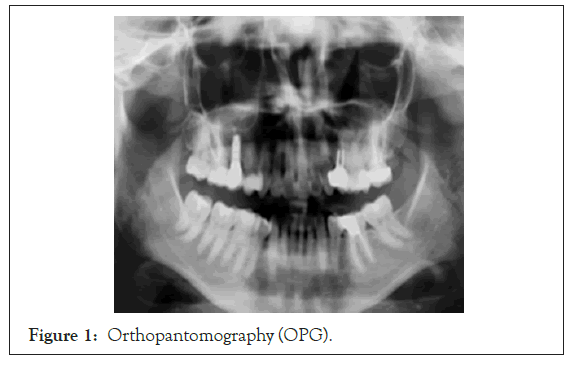
Figure 1: Orthopantomography (OPG).
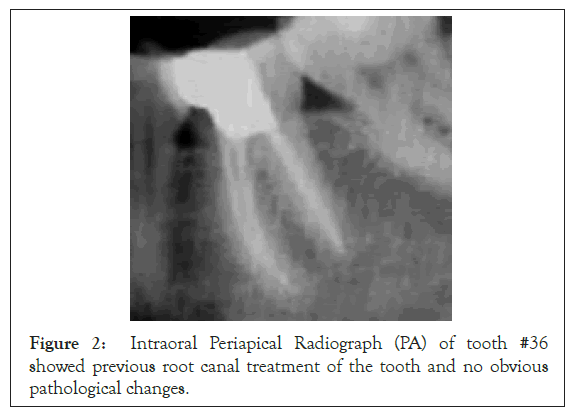
Figure 2: Intraoral Periapical Radiograph (PA) of tooth #36 showed previous root canal treatment of the tooth and no obvious pathological changes.
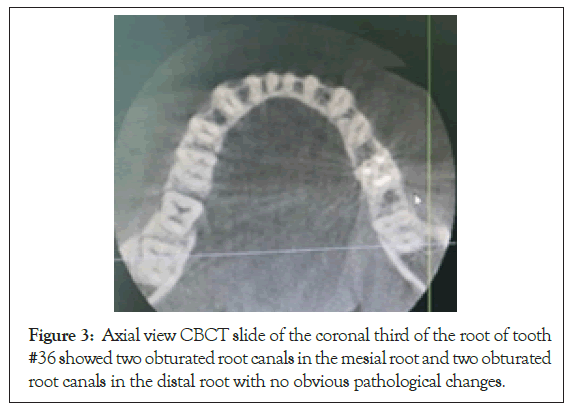
Figure 3: Axial view CBCT slide of the coronal third of the root of tooth #36 showed two obturated root canals in the mesial root and two obturated root canals in the distal root with no obvious pathological changes.
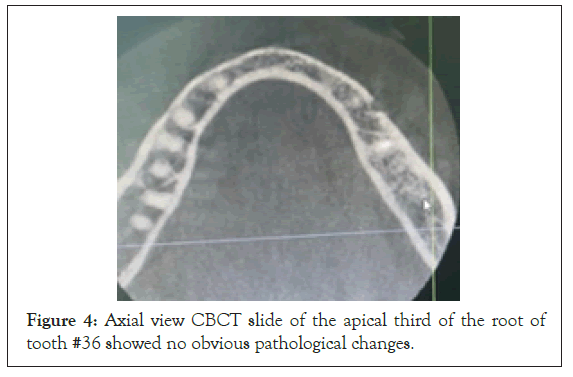
Figure 4: Axial view CBCT slide of the apical third of the root of tooth #36 showed no obvious pathological changes.
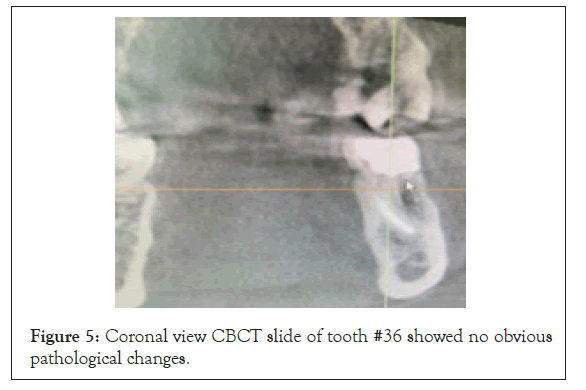
Figure 5: Coronal view CBCT slide of tooth #36 showed no obvious pathological changes.
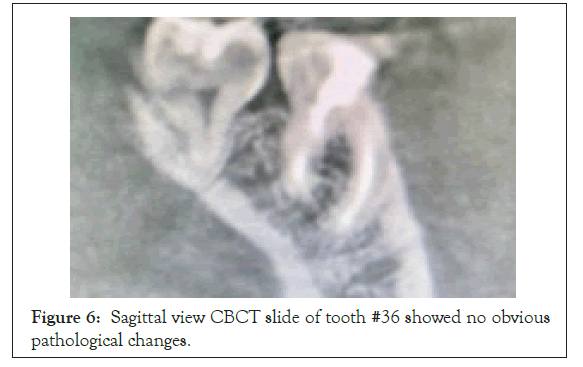
Figure 6: Sagittal view CBCT slide of tooth #36 showed no obvious pathological changes.
The initial diagnosis of tooth #36 was prior root canal treatment with symptomatic apical periodontitis.
Due to the absence of any obvious clinical and radiographic signs of symptomatic apical periodontitis and the possible side effects of the COVID-19 vaccine, the treatment plan was to keep the patient under observation and prescribe analgesic, then to follow up the case after one week for further evaluation and management.
The patient was taking paracetamol 500 mg three times a day as prescribed by the treating family physician. I prescribed 400 mg ibuprofen to be taken alternatively with the paracetamol three times a day for three days.
On the next visit (after one week), the patient was asymptomatic. Clinical examination revealed a completely normal response with percussion and palpation tests. The patient was assured and referred to the prosthodontic clinic for the crowning of tooth #36.
Results and Discussion
SARS-CoV-2 infection is a global health concern and has infected a significant portion of the world’s population [1]. During the COVID-19 pandemic, people worldwide faced major health care challenges, anxiety and stress, because of the lack of specific treatment, and until December 2020, lack of approved vaccination [6].
RNA vaccines have a better safety profile than viral vaccines since they are not made with an actual pathogen and do not integrate into host DNA [4]. Pfizer vaccine is administered in two doses into the deltoid muscle. A disadvantage of this class of vaccines is that they require extreme refrigeration for stability during distribution because RNA is unstable.
The oral side effects after COVID-19 vaccines were inconsistently reported with a low confidence level; they have never been reported independently [7].
Several studies of mRNA vaccines showed a higher frequency of adverse effects following the second dose [5-9]. Countries, despite the cost, are trying their best to vaccinate their citizens as early as possible, but further research is required to ensure that any COVID-19 vaccines do not trigger potential adverse effects.
Conclusion
Pfizer/BioN-Tech vaccine might lead to symptoms that mimic symptomatic apical periodontitis. The patient who develops such symptoms shortly after the COVID-19 vaccine without an apparent cause should be assured and kept under observation for one to two weeks. A tentative diagnosis and treatment plan should be considered in the follow-up visit.
REFERENCES
- World Health Organization (WHO). COVID-19 Vaccine Country Readiness and Delivery. COVAX. 2021.
- Oruonye ED, Idris M, Ahmed YM. Impact of COVID-19 on informal sector and livelihood sustainability in Nigeria: A conceptual approach. J Soc Man Sci. 2020;2:195-204.
- Attia S, Howaldt HP. Impact of COVID-19 on the dental community: Part I before vaccine (BV). J Clin Med. 2021;10:288.
- Pfizer. Pfizer and BioNTech initiate a study as part of broad development plan to evaluate COVID-19 booster and new vaccine variants. 2021.
- Riad A, Pokorná A, Attia S, Klugarová J, Koščík M, Klugar M. Prevalence of COVID-19 vaccine side effects among healthcare workers in the Czech Republic. J Clini Med. 2021;10(7):1428.
- World-First COVID-19 Vaccine Booster Study Launches in UK-GOV.UK. 2021.
- Klugar M, Riad A, Mekhemar M, Conrad J, Buchbender M, Howaldt HP. Side effects of mRNA-based and viral vector-based COVID-19 vaccines among German healthcare workers. Biology. 2021;10:752.
- El-Shitany NA, Harakeh S, Badr-Eldin SM, Bagher AM, Eid B, Almukadi H, et al. Minor to moderate side effects of Pfizer-BioNTech COVID-19 vaccine among Saudi residents: A retrospective cross-sectional study. Int J Gen Med. 2021;14:1389.
- Menni C, Klaser K, May A, Polidori L, Capdevila J, Louca P, et al. Vaccine side-effects and SARS-CoV-2 infection after vaccination in users of the COVID Symptom Study app in the UK: a prospective observational study. Lancet Infect Dis. 2021.
Citation: Alzahrani MS (2021) A Misleading Apical Periodontitis like Symptoms Post COVID-19 Vaccine: Case Report. J Vaccines Vaccin. 12:468.
Copyright: © 2021 Alzahrani MS. This is an open-access article distributed under the terms of the Creative Commons Attribution License, which permits unrestricted use, distribution, and reproduction in any medium, provided the original author and source are credited.

